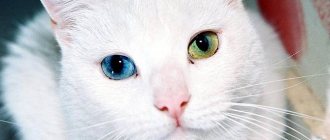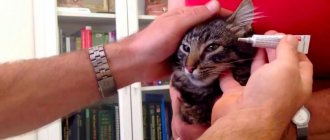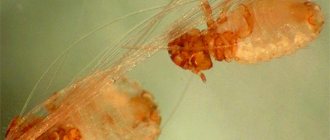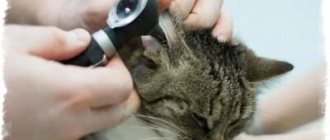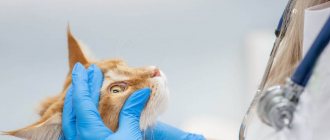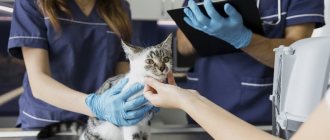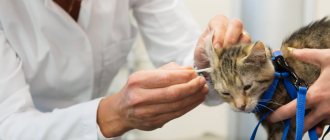Signs of blindness
A cat's blind eye is often covered with a veil, or the pupil remains dilated even in bright light.
The animal will not be able to say that it sees poorly. However, a person can determine by certain signs that a cat has lost its sight:
- the animal stops moving a lot and spends more time dozing;
- walks only on the floor, jumps less or not at all;
- walks around the house carefully;
- The blind cat's whiskers are broken off. This is due to the fact that the whiskers are the main sensory organ of a blind cat. With them she feels the world, catches vibrations in the air;
- eyes do not glow in the dark;
- while moving, it crashes into objects that are not located in their usual places.
A cat that is blind in one eye may lash out in self-defense if you make sudden movements on its blind side.
Video
More photos Author(s):
Lyubov Solomakhina
Magazine:
No. 5 - 2015 This is usually the phrase of the owners of elderly cats who have lost their sight when they come to see me.
The pupils of such cats are fixed and dilated (Fig. 1)
.
In addition, there is a feeling that translucent “sheets”, usually with a reddish tint, are floating in the pupil, right behind the lens (Fig. 2-5)
.
This is nothing more than a detached retina, which, due to the accumulation of subretinal effusion, is raised upward and is thus visible through the pupil directly behind the lens using a conventional focal light source, even without ophthalmoscopy. I call this picture “scarlet sails”... This is the association I have when I see bullous retinal detachment with hemorrhages that give a reddish tint when examining dilated pupils. However, in cats, even with complete bilateral retinal detachment, striking compensation is observed. In such cases, blindness can be detected when the animal finds itself in an unfamiliar environment. Typically, there is a history of symptoms of systemic disorders in the form of polyuria-polydipsia, disorders of the urinary system and gastrointestinal tract, weight loss, and seizures (which are often mistaken for epilepsy). The most common cause of this condition in older cats is chronic renal failure and secondary arterial hypertension, which can also manifest itself as a convulsive syndrome. In addition, the cause of hypertension may be related to heart failure, feline hyperthyroidism, etc. Sometimes arterial hypertension in cats can be primary (idiopathic). It is important to remember that changes in the fundus appear in the early stages. Initially, this may be increased tortuosity of arterioles (Fig. 6)
or the appearance of small hemorrhages on the retina
(Fig. 7)
, local retinal detachments without loss of visual function
(Fig. 8-12)
.
Owners at this stage usually do not notice vision problems in their pet. Considering that cats are well oriented in their familiar surroundings, owners usually notice vision loss when there are already catastrophic changes in the fundus of the eye in the form of complete retinal detachment or extensive hemorrhages (Fig. 13-15)
.
Therefore, veterinarians need to examine the fundus of all cats over 5 years old 2 times a year! Back to section
In what cases can vision be restored?
Eye diseases can occur in cats at any age, but are more common in older animals.
A cat can go blind for several reasons. This may be a congenital disorder, due to illness or old age. Treatment depends on the reason for the cat's blindness.
The main causes of blindness are:
- Glaucoma. A concept denoting a disease due to which an animal’s intracranial pressure increases. The disease is most often treatable. It all depends on the reasons that caused glaucoma.
- Cataract. Most often, older cats suffer from cataracts. In this case, vision is lost gradually. If you notice changes in your pet's behavior, cataracts can be cured or its development can be slowed down.
- Uveitis. Inflammation of the vascular system of the eyes. As a result of this disease, glaucoma may develop. Inflammation can be completely cured if the disease is not in an advanced stage. Neoplasms put pressure on blood vessels and nerve endings in the animal’s brain. If measures are not taken, the animal may die.
- Retinal atrophy. Most often it is a hereditary disease that occurs secretly. Leads to complete and irreversible loss of vision.
- Hypertension. Thyroid dysfunction leading to retinal detachment. It can be cured if diagnosed correctly. Otherwise, retinal atrophy will develop.
Blindness in cats
Vision loss (blindness) in cats can be sudden or develop gradually. Often, owners do not notice that their cat is losing vision, so it is necessary to pay attention to the behavior and health of their pet every day, regularly call a veterinarian at home or undergo an examination by a veterinarian in the clinic.
If there are vision problems, the cat behaves insecurely and bumps into walls and furniture. Cats are naturally good jumpers, so if your cat falls when jumping or misses its target, it could indicate a vision problem. The cat may vocalize more, feel insecure, and look scared.
Sometimes changes in the eyes are observed - dilated pupils that do not respond to bright light, different pupil sizes, changes in eye size. All of this may indicate vision loss.
There are different reasons for the development of blindness in cats:
Retinal disease. Unfortunately, whether the cause of vision loss is progressive retinal atrophy or degenerative changes, there is currently no treatment or cure. Most animals diagnosed with these diseases will eventually become blind. But they can adapt quite easily due to the gradual decrease in vision.
Uveitis, or inflammation of the uvea, is a common disease that causes blindness in cats. Owners may notice different pupils, redness, pain, discharge and swelling. Since there are many causes of uveitis, including infections and tumors, it is important to show the animal to a veterinary specialist in the clinic as soon as possible or call a doctor at home for an examination.
Cataracts are much less common in cats than in dogs and can develop in one or both eyes, eventually leading to blindness. This eye condition occurs when the lens becomes opaque or cloudy, causing progressive vision loss.
Glaucoma is a condition that occurs when intraocular pressure increases. High pressure affects the optic nerve, which ultimately leads to irreversible changes. In the early stages of glaucoma, symptoms of vision loss in a cat may include rapid blinking, dilated pupils, cloudy eyes, or dilated scleral vessels.
Diabetic retinopathy - Most cats with diabetes experience weight loss, lethargy, vomiting, depression, increased thirst and frequency of urination, and problems with movement.
What to do if your cat is blind?
Regardless of the cause and stage of blindness, it is necessary to monitor the state of vision by a veterinary ophthalmologist, especially if the animal has suddenly lost its vision. In this case, he will need additional help to adjust to his new life. First you need to limit the living space of the animal. Once your cat feels more comfortable, you can gradually expand the boundaries.
Since blind cats are highly dependent on sound, they should not be left in a noisy environment.
The article was prepared by A.M. Starovoytova,
veterinary ophthalmologist at MEDVET © 2021 SEC MEDVET
Belova
Editor of the section “Dermatology”
Practicing veterinarian, lecturer in veterinary dermatology and allergology at the Estonian Agricultural University, diploma holder of the European College of Veterinary Dermatology
In 1995 she graduated with honors from the Estonian Academy of Agriculture with a degree in veterinary medicine. From the moment of graduation to this day, he has been a practicing veterinarian, specializing in dermatology for the last 12 years. The main patients are dogs and cats, less often horses and other animals. Trained in the best dermatological clinics under the guidance of leading specialists, for example:
- 2000–2001, dermatological clinic of Dr. D. Carlotti in Bordeaux, France.
- 2004, Dermatology Department, Pet Clinic, The Royal (Dick) School of Veterinary Studies in Edinburgh, Scotland.
- 2005, Dermatological Department of Veterinary Clinic, University of California (Davis), USA.
- 2006, 2008, Department of Dermatology, Small Animal Clinic, University of Munich. Ludwig Maximilian, Germany.
- 2007, Department of Pathology, Veterinary Faculty, University of Bern, Switzerland.
- 2010, Department of Dermatology at the Small Animal Clinic and Equine Clinic of the Veterinary Institute in Uppsala, Sweden.
- 2011, Department of Dermatology, Small Animal Veterinary Clinic, University of North Carolina (Raleigh), USA.
Since 1999, he annually takes part in international veterinary congresses, seminars and master classes. Since 2005, he has been lecturing on dermatology at the Estonian Agricultural University, teaching senior students in clinical dermatology. From 2007 to 2011 she completed a residency program at the European College of Veterinary Dermatology at the University of Zurich. Member of the European Society of Veterinary Dermatologists, member of the International Society of Veterinary Dermatopathologists, member of the Estonian Small Animal Veterinary Association. Actively participates in postgraduate education, receiving trainees from Russia and the Baltic states at the clinic, participating in conferences and master classes organized in Estonia, Latvia, Lithuania, Russia, Ukraine, Belarus, Poland, Hungary. She gave her first lectures on dermatology in 2002 in Latvia. To date, she has prepared and delivered more than 60 lectures and master classes on dermatology in Russian, English and Estonian.
In 2010, she won the Golden Scalpel award in the Lecturer of the Year category. The Estonian Veterinary Association awarded the title "Best Veterinarian 2010".
Professional interests: patients with atopic dermatitis, histopathology, clinical photography.
Happily married, has a daughter, Christina. And of course, there were pets - the family has two beagles, two cats, a horse and a hamster.
Hobbies: traveling, horse riding.
How to determine pathology?
An unsteady gait and cautious, slow movements may indicate the animal is blind.
If an old or young cat for some reason has ceased to see normally, you can understand that something is wrong with the animal by the following symptoms:
- Careful, slow movements in a familiar room.
- In an unfamiliar place, the animal tries not to move, looks closely for a long time, and bumps into objects.
- The cat refuses to jump or climb to heights.
- The gait becomes unsteady.
- The gaze is cloudy, the pupils are large, and do not respond to light stimuli.
- The cat becomes shy, fearful, and nervous.
Return to contents
At what age do kittens' eyes open?
Typically, the eyes open between 5 and 10 days of life, but there are factors that can significantly change this timing. Such factors include the breed, length of pregnancy of the cat and even the living conditions of the kittens.
Interesting materials:
Where can you exchange change in Odessa? Where can I find settings in Odnoklassniki? Where is the cart in Opera? Where in the sentence is so far put? Where are likes in the VK application? Where can I find the recycle bin in Samsung? Where is screen recording in Samsung? Where in the retina are there more rods? And where are the cones? Where is the play market on your smartphone? Where can you eat delicious fish in Sochi?
Is there a chance for a newborn blind kitten?
Faced with an animal's blindness at a young age, the owner wonders how
a kitten will exist without such a vital sense organ.
Having gone blind early, the kitten will perfectly navigate familiar surroundings using other senses.
Of course, there can be no talk of any free walking on the street, where the animal faces many dangers. A disabled cat should only be taken for a walk on a harness under close supervision. It is also advisable not to rearrange the furniture in the room, so as not to disorient the animal.
From pets that become blind at an early age, companion cats grow up, following their owner always and everywhere. Having good hearing, blind animals actively respond to the owner's voice. A disabled cat will be happy to take part in active games. For this purpose, it is necessary to use toys with a sound signal.
Blindness in a domestic cat can occur for many reasons. In this case, acquired vision loss is most often diagnosed in veterinary practice. When blindness develops, the first thing that changes is the behavior of the animal.
An ophthalmological examination using modern diagnostic methods will not only reveal the fact of the pathological condition, but also determine the cause and treatment strategy. For domestic cats, blindness is not a death sentence and, with proper care, does not cause problems for the owner.
Other causes of dilated cat pupils
It is often not immediately clear why cats have dilated pupils. Saucer eyes are also observed in furry cats at the moment when they are hunting - no matter a bird sitting on the window, or a piece of delicious sausage on the table. While jumping and climbing through the cabinets of your beloved pet, you can also notice its almost black iris. It’s definitely worth mentioning cat weddings, during which the animals’ pupils also dilate under the influence of adrenaline and other hormones.
The reason for the large size of the pupils is also severe pain. In this case, the condition is accompanied by refusal to eat, apathy, possibly half-closed eyes and an unnatural posture.
Pharmacological drugs - medicinal valerian, anesthetics - can cause pupil dilation. For example, when a cat is given anesthesia, the increased pupil size remains for 24 hours after recovery from anesthesia. The pupils return to normal when the substance is completely eliminated from the body.
